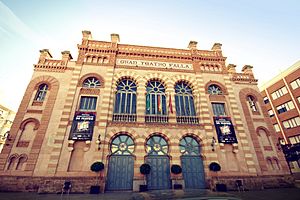Gran Teatro Falla facts for kids
The Gran Teatro Falla is a famous theater located in the sunny city of Cádiz, which is in the Andalusia region of Spain. You can find it in Plaza Fragela, right across from the Casa de las Viudas and next to the Faculty of Medicine at the University of Cádiz. It's a really important building for the city's culture and arts!
Contents
Building a Masterpiece: The Theater's Story
The journey to build this amazing theater started way back in 1884. An architect named Adolfo Morales de los Ríos drew up the first plans. Before this, there was another theater made of wood on the same spot, built in 1871. But sadly, that wooden theater burned down in 1881.
Building the new theater was a big project! In 1886, the city government took over to make sure it got finished. Sometimes, work would stop because there wasn't enough money, but they kept going. Finally, the theater was completed in 1905. Another architect, Juan Cabrera de la Torre, made some important changes to the original plans.
For many years, it was simply called the "Gran Teatro." But in 1926, it was given a new name to honor a very special person: Manuel de Falla. He was a famous composer who was born right there in Cádiz!
What Makes It Special: Design and Style
The Gran Teatro Falla is built in a unique style called Neo-Mudéjar. This style often uses red brick and designs inspired by old Spanish and Moorish architecture. You'll notice it's made of red brick, which gives it a warm, inviting look.
The front of the theater has three grand doorways, shaped like horseshoe arches. These arches have alternating red and white bricks, which looks really cool! When you walk through these doors, you enter a large lobby area. This area was updated in the 1920s. From there, stairways lead up to the seating areas, which are shaped like a "U" or a horseshoe.
The stage inside is quite big, about 18 meters (or 59 feet) wide and 25.5 meters (or 84 feet) deep. If you look up at the ceiling, you'll see a beautiful painting by Felipe Abarzuza y Rodríguez de Arias. It shows an "allegory of Paradise," which is like a symbolic picture of heaven.
What Happens Inside: Shows and Celebrations
Every February, the Gran Teatro Falla becomes the heart of the famous Carnival of Cádiz. During this time, it hosts exciting artistic competitions where groups perform songs and acts. It's a huge event for the city!
From 1987 to 1991, the theater underwent important repairs and restoration work. While it was being fixed up, the Carnival competitions were held at another place called the Teatro Andalucía.
For the rest of the year, the Gran Teatro Falla is a busy place! It hosts all kinds of performances, from exciting plays to wonderful concerts. It's a place where people can enjoy many different types of art and entertainment.
See also
 In Spanish: Gran Teatro Falla para niños
In Spanish: Gran Teatro Falla para niños


